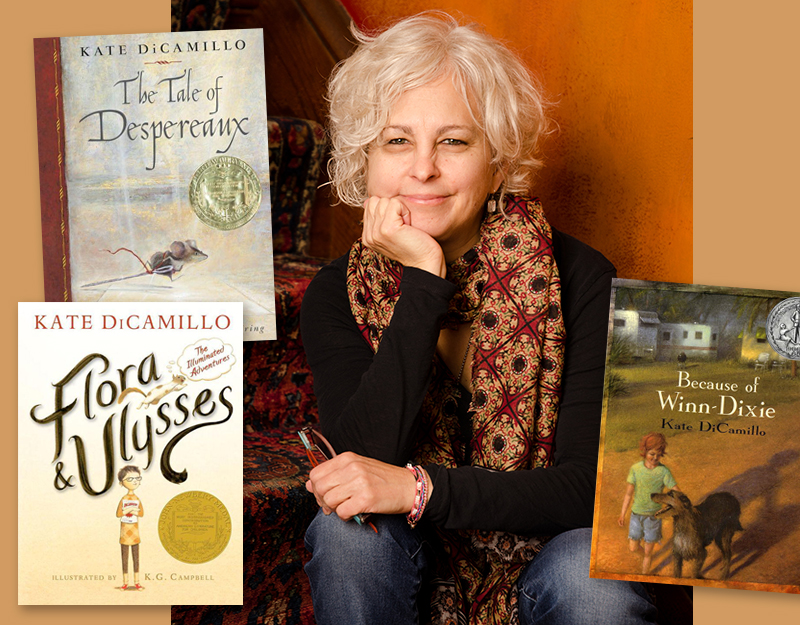Kate DiCamillo: "The World Is Full of Wonders" | The Newbery at 100
DiCamillo, who won two Medals and an Honor for her books, talks about the power of the Newbery award, creating story worlds without an outline, and the benefit of carrying a notebook.

Kate DiCamillo writes of the sorrows and joys of childhood with a sprinkle of hope and a dash of humor. She captures these sentiments by sending a minuscule mouse to the dark recess of a dungeon to save himself and a princess, or by having a magical squirrel befriend a kid and save the day. The author imbues her narratives with respect for her young readers, never pandering or veering off to the didactic. She can write about a buttered toast–loving pig’s misadventures while conveying the inner humanity and importance of community, with a helping of fun for good measure.
DiCamillo is a two-time winner of the John Newbery Award for The Tale of Despereaux in 2004 and Flora & Ulysses: The Illuminated Adventures in 2014. In 2001 she was awarded a Newbery Honor for Because of Winn-Dixie (all Candlewick). Here, she speaks about writing and some shiny medals.
How has winning the Newbery Award (twice! And an Honor!) changed or affected your writing? What hasn’t changed?
I keep the medals (the plural still astonishes me) in a drawer in my desk. I don't look at them. I try not to think about them, but I know that they are there. I kind of feel like my job is to get out of my own way and tell the story—not think about whether it's any good, or if I'm doing it right, or if people will like it.
Every once in a great while, though, I will slide open that drawer (middle, left), reach into the very back, put my hand on those medals and think: "That happened. What a miracle. What a gift." Then I will close the drawer and go back to work.
What have the awards afforded you that people might not realize? What do you hope young people walk away with after reading your books?
I think that the Newbery is such a powerful literary award. It virtually guarantees that the book will stay in print. I remember being a kid in the library, looking at the spin rack of Yearling Newbery paperbacks, knowing to look for that medal. It just undoes me to think that some kid somewhere might select a book I wrote because the medal is there, and that they will read about the mouse or the squirrel and feel comforted, less alone.
You write eloquently about the brave, and sometimes terrifying, moments of being a child. How do you create the characters and world where they inhabit?
A story, for me, usually begins with an image or a name or a character. Then I follow those clues to the wider world of the story. The eight-year-old in me is always present, and helps me to see that world, to imagine it, and inhabit it—to hope and wonder in it.
Are you a “panster,” or do you love a new set of notecards and an outline?
Oh, I am a panster through and through. I've never used an outline. I do write random notes in my journal and in my notebook that I carry around with me—insights that pop into my head, sudden illuminations. But writing the book is like walking down a long dark hallway. There's a line of light under the door, and I just kind of walk toward that slowly, slowly, always hoping.
Which of your books was your favorite in terms of writing—meaning the most delightful to write? Which of your books impacted the inner heart of your heart the most?
I remember a kid asking me once in an auditorium somewhere: "I cry when I read the book. Do you cry when you write the book?" And I said, "Yes. Always." So to answer the question which one impacted the inner heart of my heart the most: that's kind of impossible. They all get to me in different ways. I feel all of them.
Which was my favorite to write? That's hard to answer, too. Maybe Because of Winn-Dixie. It was the first book. I didn't know what I was doing. All I knew as I sat there every morning was that I had found what I was supposed to do. I was so happy.
What advice do you have for writers or people pursuing creative endeavors, or even trying to live a more creative life à la Elizabeth Gilbert in Big Magic?
Mostly this: be kind to yourself. Be patient with yourself. Do the work. And keep a notebook. The notebook is a reminder to me to keep everything open: my heart, my mind, my ears, my eyes. The world is full of wonders.
Karen Ginman is a librarian, certified teacher, and writer, currently working as the manager of collections & digital resources for Herrick District Library in Holland, MI. Find her on Twitter @karenginman.
RELATED
The job outlook in 2030: Librarians will be in demand
The job outlook in 2030: Librarians will be in demand
ALREADY A SUBSCRIBER? LOG IN
We are currently offering this content for free. Sign up now to activate your personal profile, where you can save articles for future viewing






Add Comment :-
Be the first reader to comment.
Comment Policy:
Comment should not be empty !!!